Church texting services are crucial to your church’s communication strategy. Emails, church phone trees, newsletters, and bulletins are no longer enough to engage with your congregation.
The messages via these channels are either not read, or simply ignored (without a response).
In contrast, church SMS has a higher chance of being read instantaneously (90% of texts are read in the first 3 minutes), and also responded to!
Which is why, adopting a texting service for churches can make your communication more effective. It can bring your congregation closer and enable you to reach them instantly.
How do church texting services work?
Texting services for churches enable sending a text to its congregation at the push of a button.
There are usually two options to send ministry texts:
- Mass texting service for churches – where you can send a text blast to all the members on your list.
- Peer to peer texting service for churches – where your church can have a personal one to one conversation with each member, and ask them for their inputs.
The easy (and most popular) is the mass texting service, with 40% of churches using it to keep their congregation updated about their latest events.
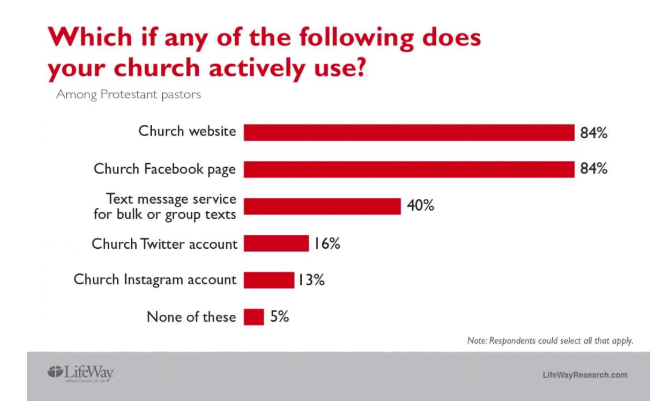

However, using only a mass text messaging for churches can still leave a gap in your communication.
A bulk text does not enable a back and forth communication with your members. Nor does it allow you to collect feedback from your members to see what you can do better.
In short, it makes your congregation feel uninvolved in the church’s proceedings. Which is why using a combination of Peer to Peer SMS service and mass text can get you better results.
How to use church texting services for your ministry?
Your communication strategy and the existing shortfalls in the current system defines how you can use a texting service for your church.
For instance, if you notice that your fundraising emails do not have enough engagement, then you can send the info via a text as well.
Here are 7 ways your church can use texting service:
- Boost membership by enabling members to opt-in via SMS
- Keep new members involved by following up with them after sermon
- Increase attendance by sending reminders and updates about important events
- Simplify fundraising and collecting tithes via texts
- Increase engagement by collecting feedback and suggestions
- Automate emergency responses using bulk SMS
- Keep up with your congregation with simple ‘everyday’ texts
- One to one Pastor Chat with Peer to Peer texting
Depending upon what your objectives are, you can either send a mass text or a peer to peer SMS for the above.
Boosting new membership via SMS
There has been a drastic decline in church membership over the years.
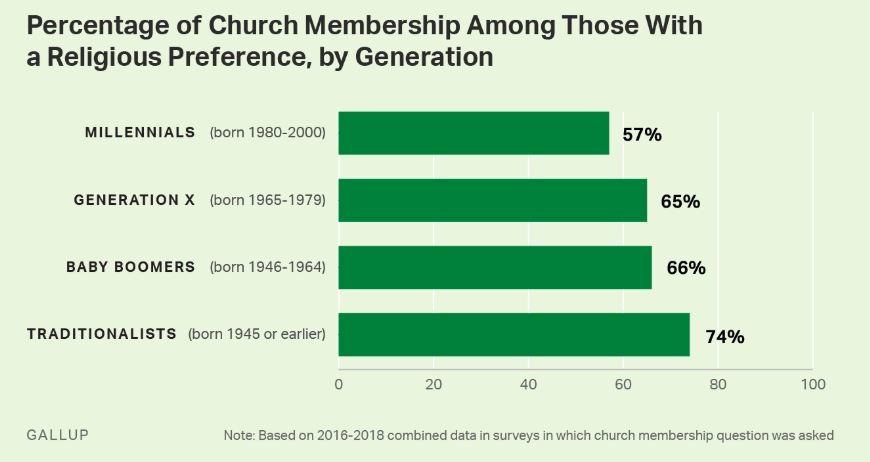

A simple way to address this problem would be to enable memberships via a channel that appeals to Millennials and GenZs – opt in text messages.
You can advertise a keyword and a shortcode that interested parties can text in to learn more about your church. Here is how it can go:


Alice gets automatically added to the text messaging roster. She can be sent more information on how to join the congregation, and the upcoming events to participate in.
Notice how Alice is sent an automated response requesting more information. Even though this is a bulk text, the details collected can be automatically stored in your church management software to be used later.
Keeping members involved with follow-ups
One of the main challenges for church communication is keeping in touch with every member in the congregation. After a sermon, it may not be possible to catch up with every member who has attended the service.
In such cases, you can send them a follow up text via peer to peer texting and have a one on one conversation with them.
Increase attendance with notifications and reminders
A simple way to boost dwindling sermon attendance would be to send a bulk text to all the members of your congregation about the upcoming event.
Keep in mind that the text you send should be in addition to the announcement from the pulpit. Ideally, they should have already heard about the event from you (in person/ from the bulletin boards), and the texts will only serve as a reminder to attend.
You can also use texts to keep your congregation updated about schedule changes for different events.
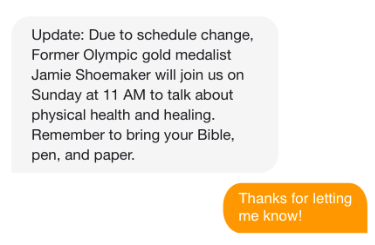

In the above example, a church member chose to acknowledge the message sent via a response. Remember that they can also text back requesting more information about the event.
So you may have to schedule some time to reply to the responses you get (if needed).
Simplify fundraising by collecting tithes via texts
Text to give or text to donate can be powerful ways to request funds from your congregation. You can either send them text with a link to your donation page. Or, you can ask them to text in the amount they want to donate.
If you are holding a ticketed event fundraiser, the text message can be sent with a link to buy tickets.
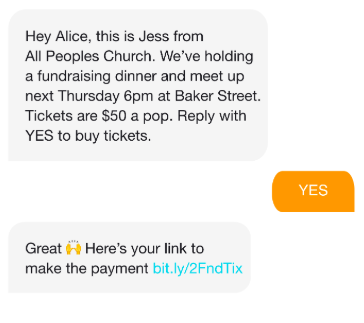

Notice how this text sends the link to tickets after getting a confirmation from the member. These responses can of course be automatically handled, or sent via P2P text for a more personal conversation.
Keep in mind that this form of fundraising is more powerful when combined with other communication methods. For instance, while you are announcing a new initiative from the pulpit, you can send a text message and ask everyone present to donate via text.
Increase engagement by collecting feedback
One way to make your congregation more involved in your church’s activities is to pro-actively reach out to them and ask them for feedback.
For instance, due to social distancing, you can check with your congregation on how they would like to proceed with this year’s annual fundraiser. That is, instead of a bake sale, would they be willing to participate in a live auction?
Based on the responses you get, you can pick the most popular recommendation and start planning for it.
If you want to send this text to only select members, you can filter them out from your management software and then upload the list to your church texting services’ software. The mass text message can subsequently be sent to only these members.
Apart from events, you can also use text messages to ask them questions on what to improve and identify the gaps better.
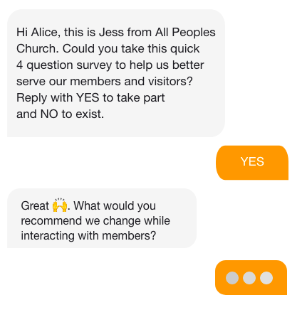

Not only will it help you streamline your process, it will also make your members feel heard – and thus improve engagement.
Automate emergency responses using Bulk SMS
Due to the ongoing global pandemic, we live in very uncertain times. Now is the time when your community would need to come together in faith to emerge stronger.
Call of prayers and special sermons can be the perfect way to give them emotional support. You can send out these requests via a bulk text message to all your members and ask them to show solidarity.
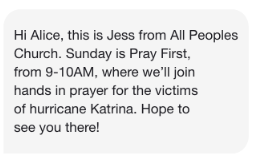

Keep up with your congregation with ‘every-day’ texts
Using a mass text messaging service, you can send your congregation ‘a scripture for the day’ or thought for the day.
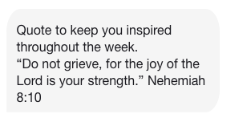

Such simple but consistent communication will help them feel a sense of belonging to your church and watch out for the texts you send.
One to one pastor chat via peer to peer texting
A lot of church websites now have online chat that helps visitors directly connect to a pastor and talk about their problems.
If your church does not offer that option, then an easy way to enable it is by using peer to peer texting to have that conversation.
Instead of going to your website, members can send you a text with the keyword (e.g. HOPE). You can then start a peer to peer conversation with the member via SMS and listen to their problems.
How to collect phone-numbers from your members?
The first step in using any text messaging service for your church will be getting a list of usable contact numbers for your congregation.
Building a list of such usable numbers is not an overnight task. It is an ongoing effort that needs regular upkeep and maintenance.
To get you started, here are a few touch points to ask for phone numbers
- The church website
- After a donation online
- The information kiosk (or visitor’s booth)
- An announcement from the pulpit
- Word of mouth encouragement from peers
As with any outreach/communication strategy, you need not choose one over the other. Rather, weave it all together to collect phone numbers from various channels to maximize outcome.
Church website
84% of churches have a website. It is the best place for new members to learn more about your congregation and the various activities you conduct.
Announcing your text messaging service here will easily reach more new audiences and have them subscribe to your text messages.
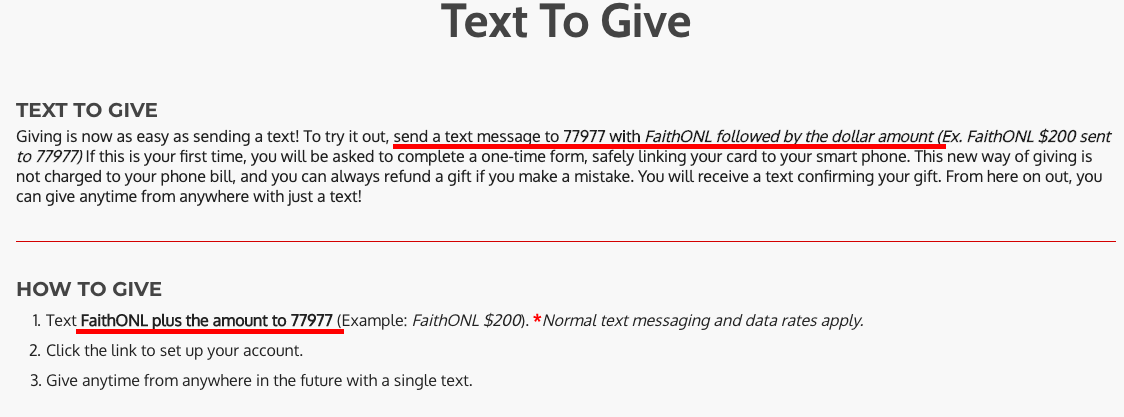

In the above example it is a text to give option that is advertised on the website. If you are using a dedicated shortcode, then you can announce a different keyword (e.g. MYCHURCH) to be sent to the same number for information requests.
Pastor Chat
We have already discussed pastor chat via peer to peer texting as a way to engage your congregation.
However it is interesting to note that pastor chat online (on the website), can be a crucial way of collecting opt-ins and information about your visitors.
For instance, here is an example of a pastor chat that asks the visitor for more information:
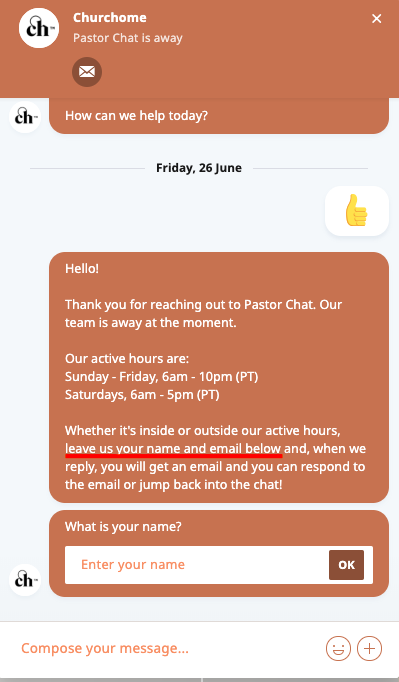

Here, instead of asking for just an email or name, you can also ask for their phone numbers. Not only will it make it easier to text them, but when they reply with their phone number, it is an automatic opt-in to send them more information via texts.
Donation thank you pages
The best place to make an ask (especially for phone number), is right after a member has made a commitment. Usually, this commitment is buying an event ticket/ donating money for a specific cause.
So in the thank you page, having an option for people to sign up to receive updates via text would be a great idea.
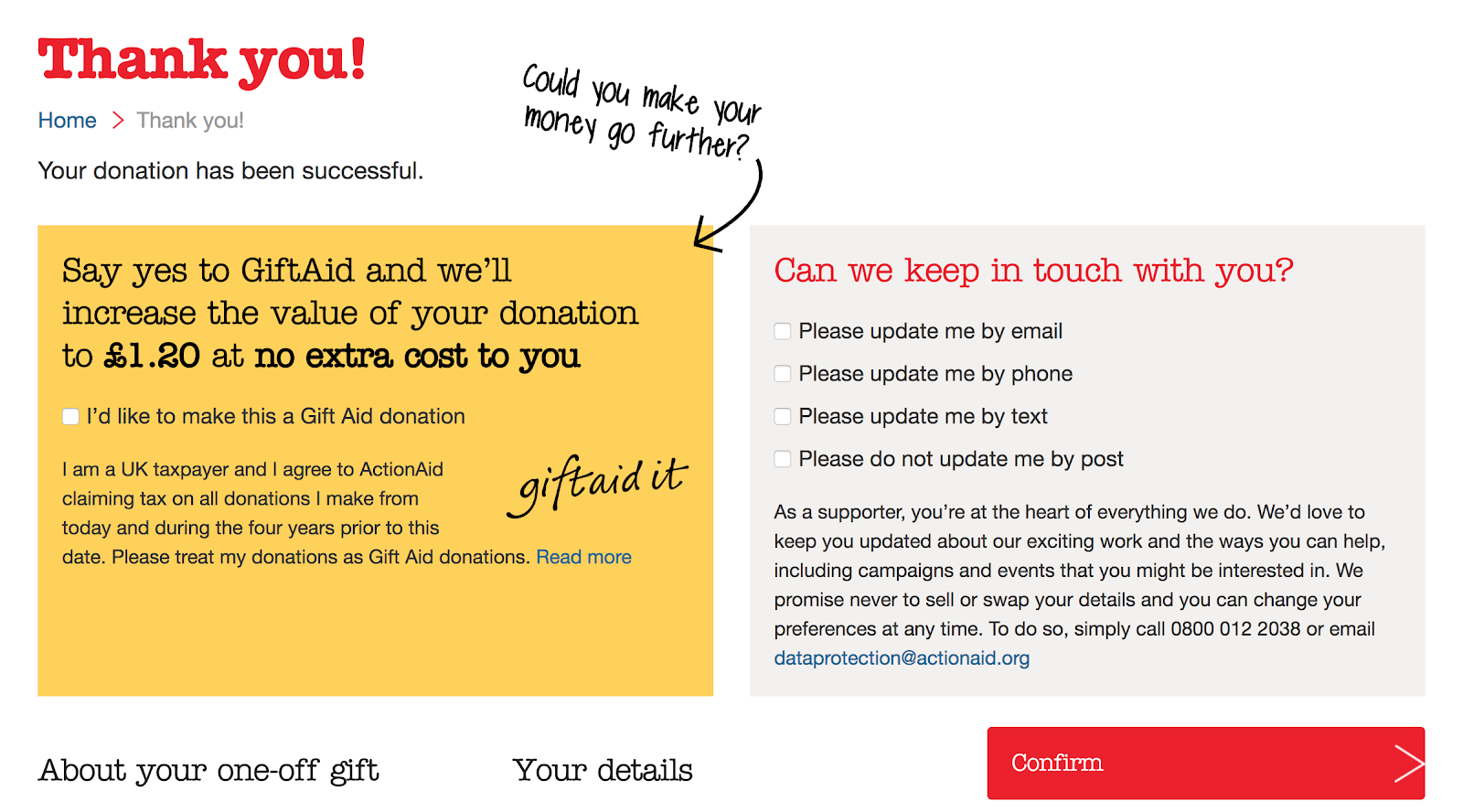

Or, you can also choose to add a small checkbox at the bottom of the donation form, asking the member to opt-in for texting updates from you.
The information kiosk
The visitors booth in your church is where a lot of new members come to learn more about your church before becoming a member.
You can ask for their phone number right here and send them information via text and encourage them to become a member.
Announcement from the pulpit
So far, the channels for collecting phone numbers are typically for new members who are looking to join your church. However, your pressing concern would be to use a text messaging service for your existing members.
You can make an announcement from the pulpit, requesting numbers to keep in touch with your members better.
Encouraging word of mouth recommendation
Easiest way to get more numbers for your list, is to encourage your existing members to inspire new members to join the list.
Peer to peer recommendation convert the fastest. And knowing first hand the advantages of a quick text communication can help other members sign up too!
Best practices for church text messaging
As with any channel of communication, texting also has certain best practices that can help you get more responses and better engagement from your congregation.
- Include your name and your church’s name. This helps the recipient form a human connect and also immediately understand who is texting them.
- Make it easy to opt-out. Ensure that every text contains information on how to opt out of text message communication with your church. It is just a better way to give your members the choice of receiving your texts and also keeping your lists updated.
- Send texts at the right time: Pick a time when your audience would be most receptive to text messages (meaning when they are most likely to read it) and send texts only then. Ensure that this timing is consistent across days so that your members look forward to texts.
- Add a call to action: If your message is important enough to be sent via text, it would be prudent to see how your audience responds to it. Adding a CTA can help you there. Eg. they can respond with more details, choose to respond Y or N, or simply click a link to make a donation.
How to set up text in church with CallHub?
Church texting services are remarkably easy to set up. CallHub is no exception – you can get started in 4 simple steps.
- Select the campaign you are interested in (usually, it is SMS broadcast for mass texting)


Pick a campaign name, and add the contact list (the list of members you want to reach)
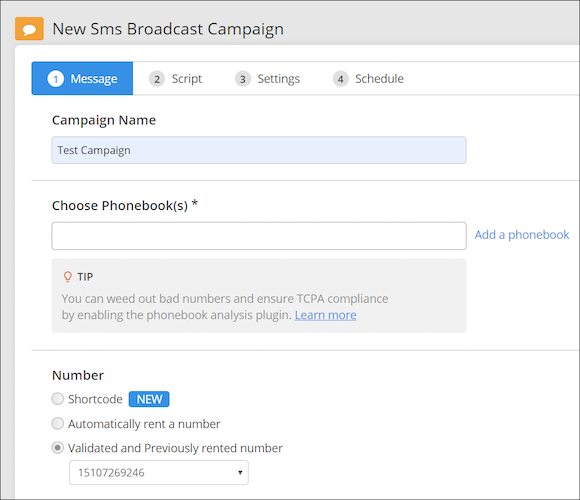

Craft a message (or add a script). This is what would be sent to your audience.
Schedule it!
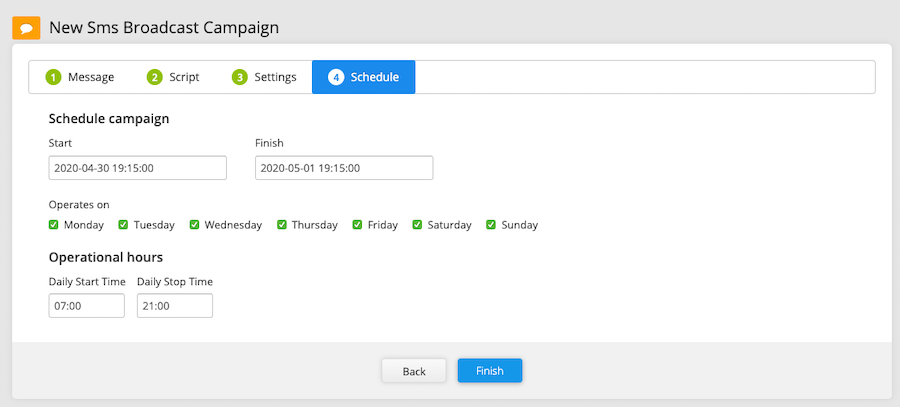

And you are done! It is as simple as that.
What I outlined above is a rather straightforward use-case where you send a mass text message. However as we discussed, most of your texts should be inline with a broader communication strategy.
That is, instead of randomly sending texts, it should have a goal behind it (e.g. increase attendance, raise more funds. etc.).
With that in mind, here is a more detailed way to set up text in church for your ministry, to streamline your communication efforts.
Let us suppose that your annual fundraising event for your church is coming closer. You want to use SMS to increase attendance and thus raise more funds for your church. Here is an example of how to go about it.
- Step 1. Send out a bulk SMS to all the members of your congregation. In that, briefly outline the proposed event and call for volunteers. Interested members can text back to the same message, with the keyword ‘Volunteer;.
- Step 2. Talk to each sign up via peer-to peer texts to see how exactly they would like to be involved. Eg. “Hi Jane, thanks for signing up to be a volunteer. Would you like to help with the organizing committee or the creative team?“
- Step 3. Based on their responses, assign them to a team, segment their contacts in your contact list and send out bulk SMS with relevant texts to each group.
- Step 4. Send out updates using bulk SMS to your congregation about the progress to keep them involved.
- Step 5. Send reminders and notifications to the guests (attendees) about the upcoming fundraising event.
- Step 6. After the event, remember to send a SMS survey to all attendees and volunteers to get their feedback and see what you can do better. This will give you valuable inputs on how you can get more from your next events.
These 6 steps can be tailored for volunteer recruitment, for encouraging guests to become members at your church and even to make the new members feel more welcome and involved. Make the most of your church texting services by using them to engage and nurture your congregation.

